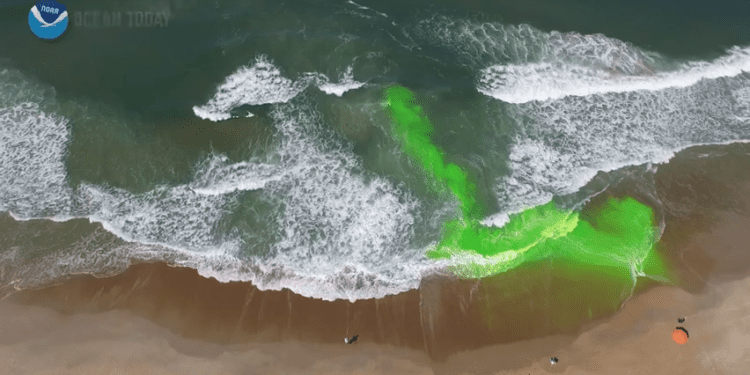Protect yourself against deadly rip currents at the beach
Watch this NOAA video to learn more about spotting rip currents and staying safe at the beach.
National Oceanic and Atmospheric Administration
As Panama City Beach, Florida, confronted the prospect of yet another summer as the deadliest beach in the United States, officials scrambled in recent weeks to stem the tide of drownings.
USA TODAY and the Panama City News Herald, a member of the USA TODAY Network, reported in June that the area was on track to lead the nation in ocean deaths for the second year in a row, according to National Weather Service data. USA TODAY was first to report on the area’s deadly record in 2023, when seven people drowned within nine days.
Rip currents in the Gulf of Mexico off Panama City area beaches have claimed the lives of seven tourists so far this year, four within 48 hours. Lifeguards last month made 21 water rescues in a single day.
Within weeks, local tourism officials boosted the area’s public safety budget. On July 9, the Bay County Tourist Development Council voted to spend an additional $600,000 with hopes of improving beach safety, spokesperson Sydney Clifton said. The money still must be approved by the county.
At a special meeting two days later, the Panama City Beach City Council ordered staff to review enhanced safeguards, such as installing flotation devices and hiring Beach Ambassadors to tell swimmers about the dangerous surf. The council also voted to add six full-time lifeguards.
“We invite the country and frequently the rest of the world to come visit our absolutely gorgeous beaches,” Panama City Beach Mayor Stuart Tettemer said. “We need to be pushing forward and making them as safe as possible.”
At the same time, police have cracked down on swimmers for refusing to stay out of the water during the most hazardous conditions, when double red flags are posted. Panama City Beach police and code enforcement officers have ticketed hundreds of people.
Preliminary reports suggest the additional safety measures are working. Officials say lifeguard assists and water rescues are down compared to this time last year. As of last week, there have also been two fewer drownings.
“What the trend is showing is that our lifeguards are now empowered to be a little more productive, and they’re making more preventative actions,” said Daryl Paul, beach safety director for Panama City Beach Fire Rescue.
Tourist drownings prompt action to increase safeguards
The seven people who drowned off Panama City area beaches so far this year were all visiting from out of state, officials said. Late last month, three men in their 20s from Alabama drowned during single red flag conditions, meaning there were strong rip currents. The day before, a 19-year-old in his first year of seminary school visiting from Oklahoma was caught in a rip current and drowned.
In early July, when the city council approved the measure to add lifeguard positions, the mayor said the city was also looking into other ways to spend the roughly $300,000 allocated by county tourism officials to improve beach safety.
“The Gulf is a wilderness. It is not a pool. It is not a lake. It is not a creek,” Tettemer said. “It is a wilderness, and it is different than the bodies of water many of our visitors are use to dealing with.”
Among the ideas city officials are considering are requiring swimmers to have flotation devices during red-flag conditions and incorporating technology to help identify struggling swimmers and notify lifeguards.
The new lifeguard positions come as the U.S. is experiencing a yearslong lifeguard shortage, shuttering community pools and leaving beachfronts unmanned, at the same time drowning deaths are on the rise.
Beach police handing out tickets for ignoring double-red-flag warnings
Beachgoers can protect themselves by checking the weather and surf conditions before they head out to swim, and heeding the warnings signified by flags at the beaches. Double red means extreme hazard, and absolutely no swimming is allowed.
So far this year, 210 people have been ticketed for refusing to get out of the water during double-red-flag conditions. That’s 73 more tickets than were issued all of last year, Police Capt. John Deegins said.
“We have to give them a warning,” Deegins said. “And if they refuse to obey, that’s when they get a ticket.”
Violators can be fined up to $500.
Flag colors include green for low hazards, yellow for medium hazards, one red flag for high hazards, and two red flags for very dangerous conditions.
In Panama City Beach and Bay County, officials never fly green flags because they say people should always be on guard in Gulf waters. It’s not always obvious when water conditions are dangerous, and flag colors are based on rip currents, not just the size of waves. A calm-looking ocean can carry deadly rip currents.
“Typically when we tell people ‘Hey, you can’t be out in the water,’ it’s not the most well-received information,” Panama City Beach Police Sgt. Zachary Rose said.
But for Rose and Deegins, angering tourists is less concerning when the goal is preventing drownings – saving their lives.
Water rescues are down and preventive education is up
Panama City Beach lifeguards have so far this year taken more than 182,000 preventive actions – that is, actions that educate the public so they are less likely to put themselves in dangerous situations.
Preventive measures have proven effective at reducing the number of necessary public assists, when lifeguards have to enter the water to prevent someone from needing to be rescued, and water rescues, when someone is pulled from the water who would have otherwise drowned.
As of last week, the city’s lifeguards have performed 308 public assists and 99 rescues, according to Paul, the beach safety director for Panama City Beach Fire Rescue. In all of 2023, there were a total of 2,542 public assists and 237 rescues.
WHERE ARE ALL THE LIFEGUARDS? Shortage grips US as drownings surge, heat rages
“You don’t want to have a lot of rescues, and that’s simply because the lifeguards’ work is proactive, and we prevent the need for rescues,” Paul said. “That is reflecting on the lower number of rescues and public assists.
“At the end of the day, we’re squeezing every little thing we can out of this lifeguard system with the current staffing that we have.”
Source link : https://www.usatoday.com/story/news/nation/2024/07/26/panama-city-beach-drownings-rip-current/74458572007/
Author :
Publish date : 2024-07-27 13:48:25
Copyright for syndicated content belongs to the linked Source.







